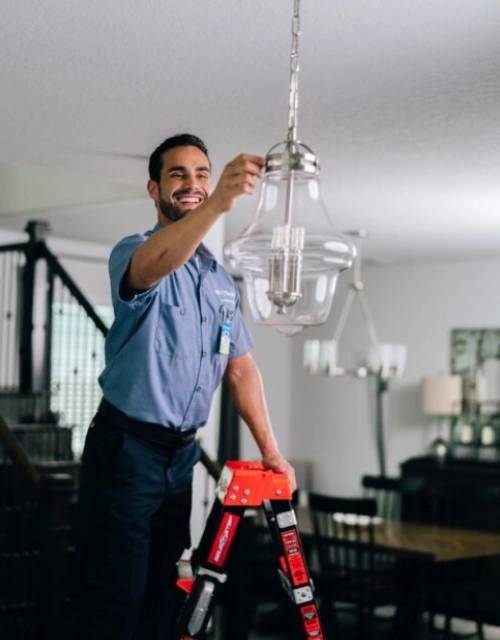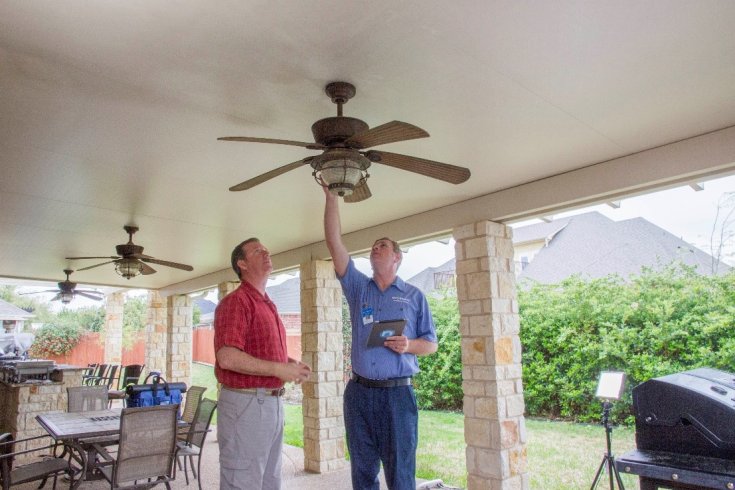Sep 22, 2024 What Is IC Rating for Lighting
If you're in the process of upgrading your home's lighting or just doing some research before a new project, you may have come across the term "IC rating." Though it might sound like an obscure industry term, understanding what an IC rating is can save you a lot of trouble. At Mr. Electric, we want to ensure our customers are fully informed about the decisions they make in their homes. When it comes to lighting installation or electrical repair service, one of the key aspects to consider is whether your lights are IC-rated. Read more to find out what an IC rating is, why it matters, and how it applies to different types of lighting fixtures in your home.
What Does It Mean for a Light to Be IC Rated?
"IC" stands for "Insulation Contact," and an IC-rated light fixture is designed to be installed in direct contact with insulation without posing a fire risk. This rating is especially important for recessed lighting, which is often installed in ceilings or walls filled with insulation. Without an IC rating, the heat generated by the light fixture could build up, posing a potential fire hazard. In contrast, non-IC-rated fixtures should not come into contact with insulation because they are not designed to handle the heat dissipation required in such a situation. If you place non-IC-rated lights in areas where they touch insulation, you increase the risk of overheating, which can lead to serious safety issues, including fire hazards. Ensuring your lights are IC-rated in insulated areas is important for maintaining the safety and efficiency of your home's lighting. When you’re not sure what kind of rating your current lighting setup has, it’s a good idea to speak with a professional electrician who can assess your home’s specific needs.
Do Surface-Mounted Lights Also Need To Be IC-Rated?
One of the common misconceptions about IC ratings is that they only apply to recessed lights. While it’s true that recessed lighting is the most frequent application for IC-rated fixtures, other types of lights, such as surface-mounted fixtures, can also be subject to these safety standards depending on where they are installed. Surface-mounted lights are typically installed on walls or ceilings and are less likely to require an IC rating unless they are installed in direct contact with insulation. In cases where surface lights are installed in insulated spaces, they might need to be IC-rated, but this depends on the specific installation and local building codes. For example, if you’re installing surface-mounted lighting in a finished basement or attic, areas that often have insulation close by, you should check whether IC-rated lights are required. Consulting an electrical repair service or a licensed electrician can help you determine whether IC-rated lighting is necessary for your specific installation.
How To Identify Whether a Recessed Light Is IC-Rated
So, you’ve just moved into a new home, and you want to check if the recessed lights in your ceiling are IC-rated. How can you tell? Fortunately, it’s relatively easy to determine whether a fixture is IC-rated. First, look inside the recessed light housing. IC-rated fixtures typically have a label indicating their rating, which is usually marked with the letters “IC.” This information may also be available on the packaging of the light or in the installation manual. The key is to look for any labels or documentation that specifically mention insulation contact approval. If you can't find the label or you’re still unsure, the best way to determine the rating is to have a qualified electrician inspect the lights. This is particularly important if you're planning to add more insulation or make changes to your home’s lighting installation. Working with a professional ensures you comply with the appropriate building codes and follow important safety guidelines.
How To Properly Insulate Around IC-Rated Recessed Lights
One of the biggest advantages of IC-rated recessed lights is that they allow you to safely insulate around them. However, even with IC-rated fixtures, there are still best practices for insulating to maximize both safety and energy efficiency. To begin with, you'll want to avoid leaving gaps in the insulation around the light fixture. Gaps can lead to drafts, which reduces the overall energy efficiency of your home and causes heat to escape. This may increase your energy bills and put more strain on your home’s heating and cooling systems. On the flip side, you should also be careful not to overstuff the insulation around the fixture. While IC-rated lights are designed to handle contact with insulation, compressing too much insulation around the fixture can lead to heat buildup, potentially shortening the lifespan of your lighting and reducing its overall efficiency. The goal is to install insulation evenly, allowing the light to operate as intended. If you’re planning a major renovation or upgrade to your home’s lighting, it’s always a good idea to bring in a professional to guide you through the process to make sure everything is safe and up to code.
Do You Need Professional Electrical Services?
Whether you're installing recessed lights or surface-mounted fixtures, knowing when and where to use IC-rated lights can prevent potential hazards and maximize the performance of your lighting system. When you work with a professional electrician, you'll know that your home’s lighting is safe and compliant with regulations. At Mr. Electric, we help homeowners and businesses make smart, safe decisions about their electrical systems. Contact us to schedule your appointment.


.webp)
.webp)

.webp)
